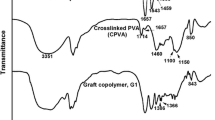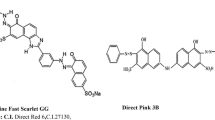Abstract
Clearing the water and wastewater from toxic heavy metals has received attentions from many researchers and scientists. In this study, poly(1-vinyl-2-pyrrolidone-co-sodium acrylate), P(VP-SA), was prepared by gamma radiation-induced copolymerization of VP and SA and utilized for the effective removal of cobalt(II), nickel(II), and copper(II) from their aqueous solutions. Effect of comonomer composition and concentration besides the adsorbed dose on the conversion percentage and the reduced viscosity was studied. The formed copolymer was characterized using Fourier transform infrared and gel permeation chromatography analysis, and the thermal stability was examined using thermogravimetric analysis. The influence of the adsorption conditions such as contact time, pH, copolymer concentration, and initial metal ion concentration on the metal ion binding capacity was tested. Pseudo-first-order, pseudo-second-order, and intraparticle diffusion adsorption models were used to explain the adsorption kinetics. Finally, the equilibrium adsorption data fitted well with Langmuir isotherm model, and the maximum adsorption amounts on P(VP-SA) copolymer calculated by Langmuir equation were 425.60, 93.01 and 450.81 mg g−1 for Cu+2, Ni+2, and Co+2, respectively.










Similar content being viewed by others
References
Gode F, Pehlivan E (2003) A comparative study of two chelating ion exchange resins for the removal of chromium(III) from aqueous solution. J Hazard Mater B100:231–243
Veli S, Alyüz B (2007) Adsorption of copper and zinc from aqueous solutions by using natural clay. J Hazard Mater 149:226–233
Schmuhl R, Krieg HM, Keizer K (2001) Adsorption of Cu(II) and Cr(IV) ions by chitosan: kinetics and equilibrium studies. Water SA 27:1–7
Chan SS, Chow H, Wong MH (1991) Microalgae as a bioabsorbents for treating mixture of electroplating and sewage effluent. Biomed Environ Sci 4:250–260
Dabrowski A, Hubicki Z, Podkoscielny P, Robe E (2004) Selective removal of the heavy metal ions from waters and industrial wastewaters by ion-exchange method. Chemosphere 56:91–106
Zhu Y, Hu J, Wang J (2014) Removal of Co2+ from radioactive wastewater by polyvinyl alcohol (PVA)/chitosan magnetic composite. Prog Nucl Energy 71:172–178
Jiang JQ (2015) The role of coagulation in water treatment. Curr Opin Chem Eng 8:36–44
Dao VH, Cameron NR, Saito K (2016) Synthesis, properties and performance of organic polymers employed in flocculation applications. Polym Chem 7(1):11–25
Saleh AS, Ibrahim AG, Abdelhai F, Elsharma EM, Metwally E, Siyam T (2017) Preparation of poly (chitosan-acrylamide) flocculant using gamma radiation for adsorption of Cu (II) and Ni (II) ions. Radiat Phys Chem 134:33–39
Saleh AS, Ibrahim AG, Elsharma EM, Metwally E, Siyam T (2018) Radiation grafting of acrylamide and maleic acid on chitosan and effective application for removal of Co (II) from aqueous solutions. Radiat Phys Chem 144:116–124
El-Reash YA (2016) Magnetic chitosan modified with cysteine-glutaraldehyde as adsorbent for removal of heavy metals from water. J Environ Chem Eng 4:3835–3847
Alyüz B, Veli S (2009) Kinetics and equilibrium studies for the removal of nickel and zinc from aqueous solutions by ion exchange resins. J Hazard Mater 167(1):482–488
Arena F, Di Chio R, Gumina B, Spadaro L, Trunfio G (2015) Recent advances on wet air oxidation catalysts for treatment of industrial wastewaters. Inorg Chim Acta 431:101–109
Fane AG, Wang R, Hu MX (2015) Synthetic membranes for water purification: status and future. Angew Chem Int Ed 54(11):3368–3386
Imran M, Crowley DE, Khalid A, Hussain S, Mumtaz MW, Arshad M (2015) Microbial biotechnology for decolorization of textile wastewaters. Rev Environ Sci Biotechnol 14(1):73–92
Crees OL, Senogles E, Whayman E (1991) The flocculation of cane sugar muds with acrylamide–sodium acrylate copolymers. J Appl Polym Sci 42(3):837–844
Craciun G, Ighigeanu D, Manaila E, Stelescu MD (2015) Synthesis and characterization of poly (acrylamide-co-acrylic acid) flocculant obtained by electron beam irradiation. Mater Res 18(5):984–993
Abdiyev KZ, Toktarbay Z, Zhenissova AZ, Zhursumbaeva MB, Kainazarova RN, Nuraje N (2015) The new effective flocculants–Copolymers of N, N-dimethyl-N, N-diallyl-ammonium chloride and N, N-dimethylacrylamide. Colloids and Surf, A 480:228–235
Pal P, Pandey JP, Sen G (2017) Synthesis of polyacrylamide grafted polyvinyl pyrollidone (PVP-g-PAM) and study of its application in algal biomass harvesting. Ecol Eng 100:19–27
Yetimoğlu EK, Kahraman MV, Ercan Ö, Akdemir ZS, Apohan NK (2007) N-vinylpyrrolidone/acrylic acid/2-acrylamido-2-methylpropane sulfonic acid based hydrogels: synthesis, characterization and their application in the removal of heavy metals. React Funct Polym 67(5):451–460
Ali AE, Shawky HA, El HAA, Hegazy EA (2003) Synthesis and characterization of PVP/AAc copolymer hydrogel and its applications in the removal of heavy metals from aqueous solution. Eur Polym J 39:2337–2344
Nho YC, Park KR (2002) Preparation of properties of PVA/PVP hydrogel containing chitosan by radiation. J Appl Poly Sci 85:1787–1794
Nud’ga LA, Petrova VA, Klishevich NV, Litvinova LS, Babenko AY, Shelegedin VN (2002) Synthesis and microbiological stability of graft copolymers of N-vinylpyrrolidone and chitosan. Russ J Appl Chem 75(10):1678–1682
Ponratnam S, Kapur SL (1976) Effect of pH on the reactivity ratios in aqueous solution copolymerization of acrylic acid and N-vinylpyrrolidone. J Polym Sci-Part A: Polym Chem 14:1987–1992
Reddy BSS, Arshady R, George M (1985) Copolymerization of N-vinyl-2-pyrrolidone with 2,4,5-trichlorophenyl acrylate and with 2-hydroxyethyl methacrylate: reactivity ratios and molecular weights. Eur Polym J 21(6):511–515
Sahiner N, Saraydın D, Karadag E, Güven O (1998) Swelling and dye adsorption properties of radiation induced N-vinyl-2-pyrrolidone/acrylonitrile hydrogels. Polym Bull 41:371–378
Yildiz U, Ferkan Ö, Hazer B (2010) The removal of heavy metal ions from aqueous solutions by novel pH-sensitive hydrogels. J Hazard Mater 183(1–3):521–532
Jin S, Gu J, Shi Y, Shao K, Yu X, Yue G (2013) Preparation and electrical sensitive behavior of poly (N-vinylpyrrolidone- co-acrylic acid) hydrogel with flexible chain nature. Eur Polym J 49(7):1871–1880
Hemalatha P, Veeraiah MK, Kumar SP, Madegowda NM, Manju M (2014) Reactivity Ratios of N-Vinylpyrrolidone -Acrylic Acid Copolymer. Am J Polym Sci 4(1):16–23
Collins EA, Bares J, Billmeyer FW (1973) Experiments in Polymer Science. John Wiley & Sons, New York
Dinu MV, Dragan ES (2010) Evaluation of Cu2+, Co2+ and Ni2+ ions removal from aqueous solution using a novel chitosan/clinoptilolite composite: kinetics and isotherms. Chem Eng J 160(1):157–163
Chapiro A (1962) Radiation chemistry of polymeric systems. Wiley-Interscience, New York
Cristallini C, Barbani N, Giusti P, Lazzeri L, Cascone MG, Ciardelli G (2001) Polymerisation onto biological templates, a new way to obtain bioartificial polymeric materials. Macromol Chem Phys 202(10):2104–2113
Wang JP, Chen YZ, Ge XW, Yu HQ (2007) Gamma radiation-induced grafting of a cationic monomer onto chitosan as a flocculant. Chemosphere 66(9):1752–1757
Dubinsky S, Grader GS, Shter GE, Silverstein MS (2004) Thermal degradation of poly (acrylic acid) containing copper nitrate. Polym Degrad Stab 86(1):171–178
Chapiro A (1979) Radiation induced polymerization. Radiat Phys Chem 14(1–2):101–116
Anirudhan TS, Rijith S, Tharun AR (2010) Adsorptive removal of thorium (IV) from aqueous solutions using poly (methacrylic acid)-grafted chitosan/bentonite composite matrix: process design and equilibrium studies. Colloids Surf A 368(1):13–22
Essawy HA, Ibrahim HS (2004) Synthesis and characterization of poly(vinylpyrrolidone-co-methylacrylate) hydrogel for removal and recovery of heavy metal ions from wastewater. React Funct Polym 61:421–432
Schweitzer GK, Pesterfield LL (2010) The aqueous chemistry of the elements. Oxford University Press, Oxford
Wu N, Li Z (2013) Synthesis and characterization of poly(HEA/MALA) hydrogel and its application in removal of heavy metal ions from water. Chem Eng J 215–216:791–801
Kalyani S, Priya JA, Rao PS, Krishnaiah A (2005) Removal of copper and nickel from aqueous solutions using chitosan coated on perlite as biosorbent. Sep Sci Technol 40(7):1483–1495
Chen H, Wang A (2009) Adsorption characteristics of Cu (II) from aqueous solution onto poly(acrylamide)/attapulgite composite. J Hazard Mater 165:223–231
Ho YS, Mckay G (1999) Pseudo-second order model for sorption processes. Process Biochem 34:451–465
Huh JK, Song DI, Jeon YW (2000) Sorption of phenol and alkylphenols from aqueous solution onto organically modified montmorillonite and applications of dual-mode sorption model. Sep Sci Technol 35:243–259
Karthik R, Meenakshi S (2015) Removal of Pb(II) and Cd(II) ions from aqueous solution using polyaniline grafted chitosan. Chem Eng J 263:168–177
Ali EA, Elkholy SS, Morsi RE, Elsabee MZ (2016) Studies on adsorption behavior of Cu (II) and Cd (II) onto aminothiophene derivatives of Styrene Maleic anhydride copolymer. J Taiwan Inst Chem Eng 64:325–335
Langmuir I (1918) The adsorption of gases on lane surfaces of glass, mica and platinum. J Am Chem Soc 40:1361–1403
Freundlich HMF (1906) Over the adsorption in solution. J Phys Chem 57:385–470
Acknowledgements
Support of this study by the Department of Nuclear Chemistry, Atomic Energy Authority, Inshas, Egypt, is gratefully appreciated.
Author information
Authors and Affiliations
Corresponding author
Electronic supplementary material
Below is the link to the electronic supplementary material.
Fig. S1
GPC curve of P(VP-SA) copolymer ([VP] = 6% (V/V), [SA] = 2.6% (V/V), VP:SA = 7:3 and dose = 4 kGy) (TIFF 37 kb)
Fig. S2
Adsorption kinetics of (a): Cu+2, (b): Ni+2, and (c): Co+2 onto P(VP-SA) copolymer by pseudo-first order (TIFF 17 kb)
Fig. S3
Adsorption kinetics of (a): Cu+2, (b): Ni+2, and (c): Co+2 onto P(VP-SA) copolymer by pseudo-second order (TIFF 35 kb)
Fig. S4
Adsorption kinetics of (a): Cu+2, (b): Ni+2, and (c): Co+2 onto P(VP-SA) copolymer by intraparticle diffusion (TIFF 35 kb)
Fig. S5
Langmuir isotherm for the adsorption of (a): Cu+2, (b): Ni+2, and (c): Co+2 onto P(VP-SA) copolymer (TIFF 17 kb)
Fig. S6
Freundlich isotherm for the adsorption of (a): Cu+2, (b): Ni+2, and (c): Co+2 onto P(VP-SA) copolymer (TIFF 13 kb)
Rights and permissions
About this article
Cite this article
Ibrahim, A.G., Saleh, A.S., Elsharma, E.M. et al. Gamma radiation-induced preparation of poly(1-vinyl-2-pyrrolidone-co-sodium acrylate) for effective removal of Co(II), Ni(II), and Cu(II). Polym. Bull. 76, 303–322 (2019). https://doi.org/10.1007/s00289-018-2379-x
Received:
Revised:
Accepted:
Published:
Issue Date:
DOI: https://doi.org/10.1007/s00289-018-2379-x




